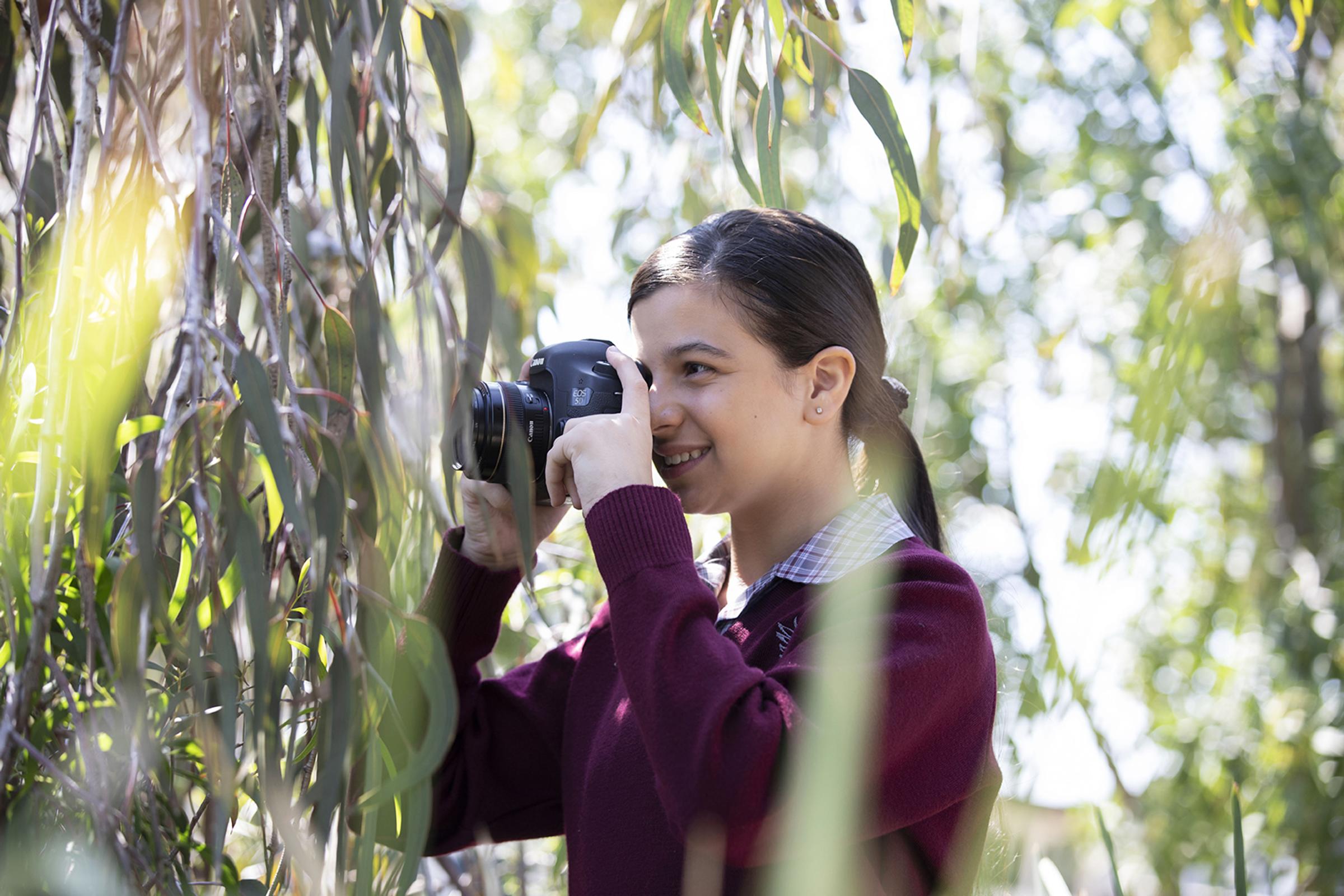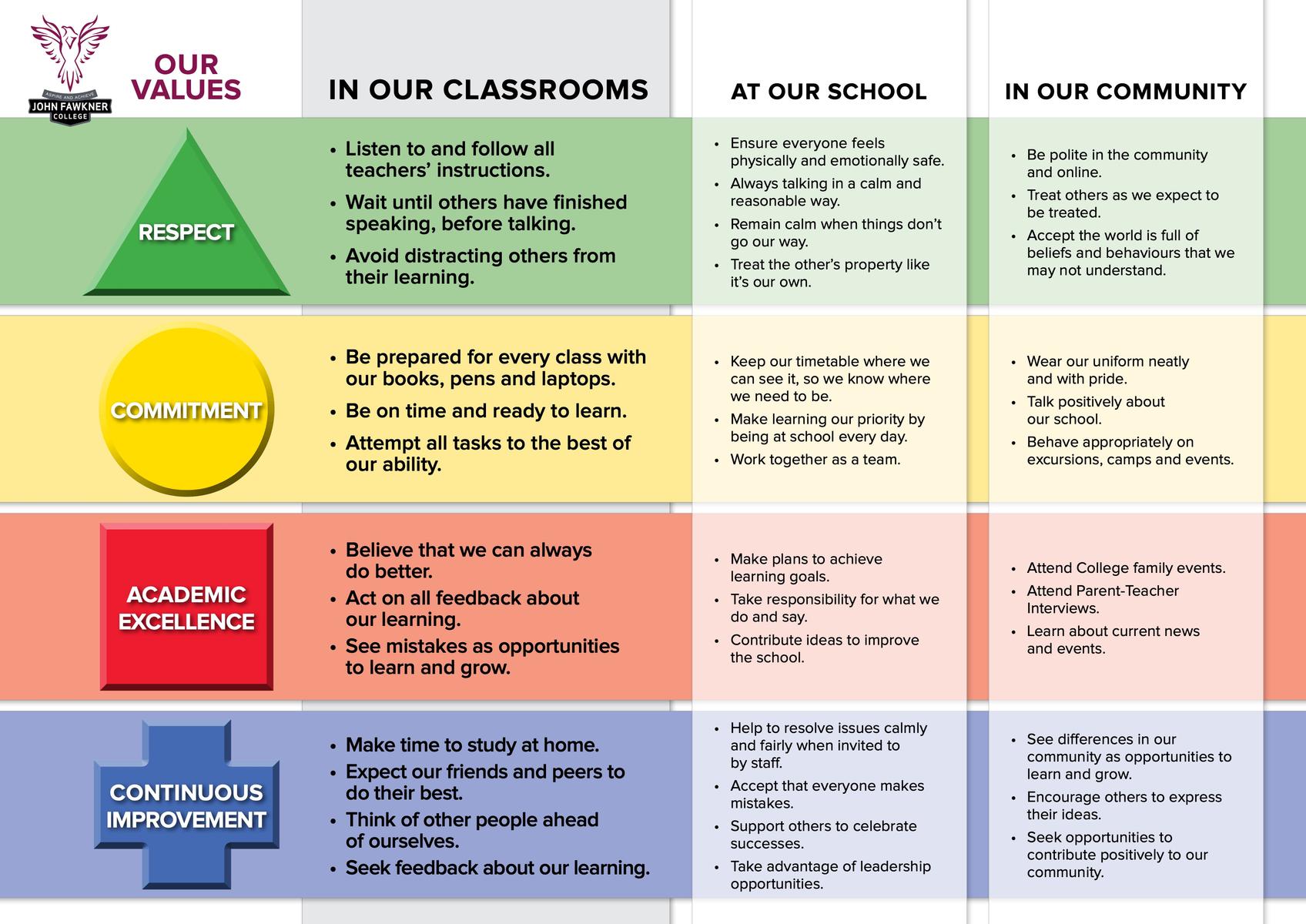Positive Rewards

Over the past few years at John Fawkner College we have been developing a culture of collaborative learning, where students work more respectfully and meaningfully with their peers and with their teachers. As in any organisation, developing such a culture is an ongoing journey and it is something we take very seriously because of the huge and positive effect it can have on student learning and results.
We are pleased and proud to introduce parents to our new ‘School-Wide Positive Behaviour (SWPBS) Matrix’ which was re-developed through 2020 by our teachers and many of our students, especially the SRC. We hope that this meets with your approval, as we have sharpened our focus on the Values that you, our parent community, selected when our first Matrix was developed in 2017 and can now be seen throughout the College. All students have set themselves a Personal Goal to improve at least one of the items mention in the Matrix – and this may be something you would like them to do at home! Students will certainly be talking about their progress towards their goals at the Parent-Teacher Conferences later this term.
It is important to remember that the dot points in the Matrix are not school rules – they are things that students should remember and aim for so that our college is a successful learning environment.
The SRC at JFC has begun the task of developing a Positive Rewards System at John Fawkner so that we can recognise and celebrate the many achievements all our students make with the learning and in living our College Goals. The SRC will be investigating far and wide to find the best parts of the best systems in school across the state, and working out how to make this happen at JFC. We are already very proud of our Vales Card system which we know is extremely popular with all students - and with the teachers for whom it enables a tangible way of showing appreciation for the efforts students make to improve and reflect our Values.
Although it is very early days we are already very pleased to reveal that over 200 Values Cards have been issued to students in just the first 9 days of schooling this year – with, extraordinarily, Year 9 leading the way. This is an extremely encouraging start.
We have included below a few tips about Positive Reinforcement which although are targeted more towards teachers, parents may find useful when thinking about how and when to reward their own children.
The Top Tips With Positive Reinforcement
- Address The Learning. When determining why a student displays certain behaviour it is important to look at and ensure that learning is differentiated, interesting and relevant for that student.
- Limit Their Use To Tangible Objects. Reinforcement is not just tangible motivators such as lollies or stickers, but also includes praise, feedback and positive comments. Rewards can also be free time, a game, time with a friend, being the leader or helper, the list is endless. In our complex roles as teachers, we play an important part in developing the whole child. The feedback we give kids teaches them how to monitor their behaviour and assess their own work, and can help them label feelings. For example, ‘Tom, you must feel proud at how much you have improved”.
- Don’t Use It Strategically. According to John Maag in his article Rewarded by Punishment, positive and negative reinforcement occur naturally in the classroom, so it makes sense to decide in advance the behaviours you want to reinforce rather than inadvertently or haphazardly reinforcing negative behaviours. Whatever you give attention to will increase in intensity and frequency so make sure you are putting more of your energy into the behaviour you want to encourage.
- Give Prompt Rewards. For a reward to be effective, it needs to be administered as close to the task as possible. When a student has to wait too long for the reward, it loses its meaning and appeal.
- Avoid Unachievable Goals. Ensure that the student can achieve the behavioural or academic goal. If you make the goal too difficult and the student does not feel that they can achieve it, they will not be motivated to put in the effort.
- Avoid under-use! Not giving enough praise and encouragement can have the impact of demotivating students and fails to teach them to celebrate small wins in their learning. If a student refuses to enter the classroom, reward entering and sitting down (once that is occurring consistently, move onto a new goal).
- Avoid Over-Use! Going overboard with praise and rewards devalues the (positive) reinforcement and can come across as meaningless. Positive reinforcement needs to be carefully aligned with the needs of the student and you need to use the least amount necessary to achieve the goal. The reinforcer can also be faded with time as the student consistently displays the behaviour i.e. they need to achieve more to receive the same reward.
- Be sincere. Reinforcement needs to be genuine and authentic to be valued by students otherwise it will not achieve your desired result. Be truthful about what has been achieved, compare it to past efforts and look towards continuous improvement.
- Give Specific Behavioural Feedback to the student. When you want students to repeat a behaviour, or learn a new behaviour it is helpful to give specific feedback about the behaviour. For example, if a student who continually calls out, raises their hand or wait their turn to speak, specific feedback reinforces the behaviour and lets them know what they did that was appropriate. Praising student effort and improvement rather than ability and talent can assist in developing a growth mindset.
- Use Rewards That Are Meaningful to the student. Sometimes teachers rack their brains trying to think of appropriate rewards for students. I have found that the best way is to go to the source. Ask the student! If they have trouble thinking of rewards, you could make some suggestions and discuss what appeals to them. Give them choices so that they don’t get bored of the same reward (we would all get sick of chocolate if that was the only reward we were ever given!)
- Keep Going! Some teachers lose heart when a student’s behaviour does not change or the reward stops working. You need to be flexible and adaptable, give choice of rewards, and persevere despite the setbacks. When you are working with a student with challenging behaviour there will be times when particular reinforcer does not work, that doesn’t mean that reinforcement doesn’t work, it means that you need to think more creatively and involve the student in the decision making.
- Don’t Use Rewards And Reinforcement As An Add-on rather than as an integral part of their teaching. When positive reinforcement is part of the fabric of your classroom, it doesn’t feel like extra work and students will participate in giving each other positive feedback and encouragement.

